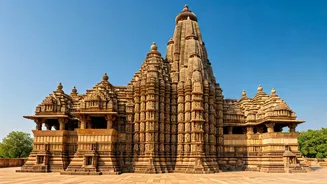Khajuraho Temples' Legacy
The Khajuraho Group of Monuments, a UNESCO World Heritage site, is the first stop on our architectural journey. Constructed by the Chandela dynasty between
the 10th and 12th centuries, these temples are celebrated for their intricate carvings and sculptures. The temples are renowned not just for their aesthetic beauty, but also for their symbolism, which reflects the essence of life and spirituality. The temples are made using sandstone, depicting various aspects of life, including both secular and religious themes. Visitors can admire the detailed depictions of gods, goddesses, mythical creatures, and daily life. The Khajuraho temples provide a unique glimpse into India's rich artistic heritage. Plan a visit to experience the serenity and historical charm this place has to offer.
Mandu's Fortified Splendor
Mandu, often referred to as the 'City of Joy,' is our second destination. It is a historical fort city in Madhya Pradesh, renowned for its architectural grandeur. Mandu boasts stunning structures from the Afghan period, offering a glimpse into the region's rich history. The architecture here showcases a unique blend of various styles, reflecting the different rulers who shaped the city. Jahaz Mahal, a structure positioned between two lakes, is designed to appear as a ship. Another structure, the Hindola Mahal, is another example of Mandu's unique architectural beauty. Travelers can explore the historical significance, artistic influences, and stories associated with these marvels, adding to their understanding of Mandu. Don't miss the opportunity to visit this historical place.
Gwalior Fort's Majesty
Gwalior Fort, a towering fortress, is a must-visit. The fort's architecture reflects influences from different eras, including Rajput and Mughal styles. The fort has impressive structures, including Man Singh Palace, known for its intricate carvings and mosaics. Also, the Teli Ka Mandir, blending Dravidian and Indo-Aryan architecture, makes the fort stand out. Gwalior Fort offers a blend of history, artistry, and military significance. The fort is strategically located, offering panoramic views of the surrounding landscape. Visitors can learn about the various rulers, battles, and architectural innovations that make Gwalior Fort an important historical site. Explore the historical splendor of Gwalior Fort.
Sanchi Stupa's Serenity
Sanchi, home to the Great Stupa, is a beacon of Buddhist architecture. The Great Stupa, originally commissioned by Emperor Ashoka in the 3rd century BCE, is one of the oldest stone structures in India. It is a symbol of Buddhist faith, showcasing intricate carvings that tell the story of Buddha's life. The Stupa complex contains several other structures, including monasteries and temples, each having unique architectural details and historical significance. The serene environment and historical importance of Sanchi make it a place for cultural and spiritual exploration. The Stupa's carvings illustrate Jataka tales, illustrating the previous lives of the Buddha. A visit to Sanchi provides an insight into the teachings and beliefs of Buddhism.
Orchha's Royal Echoes
Orchha, a historical town on the banks of the Betwa River, offers a blend of Rajput and Mughal architecture. The town is filled with palaces, temples, and forts that depict the stories of its rulers. The Jahangir Mahal, built to welcome Mughal Emperor Jahangir, demonstrates the architectural fusion. The Raja Mahal showcases the artistic skills of the Bundela rulers. Orchha's rich history and architectural designs provide a deep understanding of the region's royal past. The temples here showcase intricate carvings and religious significance. A visit to Orchha is a journey into the architectural styles of a bygone era. Discover Orchha's cultural and historical importance.
Omkareshwar's Temple Beauty
Omkareshwar, an island shaped like the sacred symbol 'Om,' is home to the Omkareshwar Temple. This temple is dedicated to Lord Shiva and is considered one of the 12 Jyotirlinga shrines. The temple's architecture showcases a blend of various styles, reflecting its historical influences. The serene environment, located on the Narmada River, offers a peaceful setting for spiritual reflection. The temple attracts numerous pilgrims. Visitors can perform various religious rituals and admire the temple's architectural design. The journey to Omkareshwar is a unique spiritual experience for those seeking peace. Plan a visit to Omkareshwar to experience its architectural beauty.












